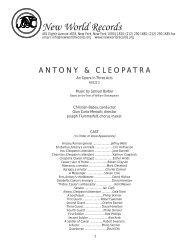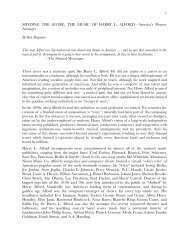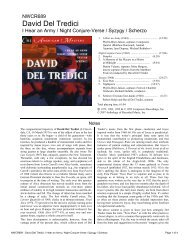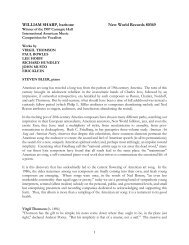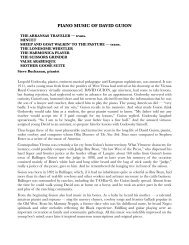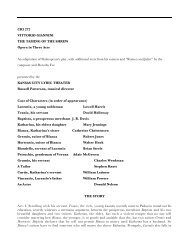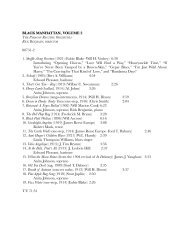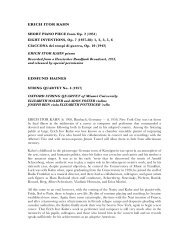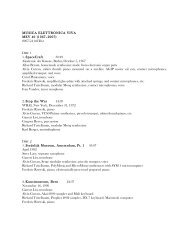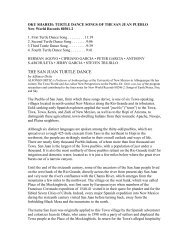JOHN CORIGLIANO, JR. Sonata for Violin and Piano - New World ...
JOHN CORIGLIANO, JR. Sonata for Violin and Piano - New World ...
JOHN CORIGLIANO, JR. Sonata for Violin and Piano - New World ...
You also want an ePaper? Increase the reach of your titles
YUMPU automatically turns print PDFs into web optimized ePapers that Google loves.
<strong>JOHN</strong> <strong>CORIGLIANO</strong>, <strong>JR</strong>.<br />
<strong>Sonata</strong> <strong>for</strong> <strong>Violin</strong> <strong>and</strong> <strong>Piano</strong> (1963)<br />
<strong>JOHN</strong> <strong>CORIGLIANO</strong>, Sr. violin—RALPH VOTAPEK piano<br />
GERALD STRANG<br />
Concerto <strong>for</strong> 'cello with woodwinds <strong>and</strong> piano (1951)<br />
GABOR REJTO 'cello — ARCHIE WADE flute — NORMAN BENNO oboe<br />
<strong>JOHN</strong> NEUFELD clarinet — DON CHRISTLIEB bassoon — GERALD STRANG conductor<br />
<strong>JOHN</strong> <strong>CORIGLIANO</strong>, <strong>JR</strong>. (b. <strong>New</strong> York City, 1938) attended Columbia<br />
University, graduating cum laude in 1959. A composition pupil of Otto Luening,<br />
Paul Creston <strong>and</strong> the late Vittorio Giannini, he gained initial recognition through<br />
Gian Carlo Menotti's Spoleto, Italy Festival of Two <strong>World</strong>s where his Kaleidoscope <strong>for</strong><br />
two pianos was premiered in 1961. That same year, Hugh Ross conducted a chorus <strong>and</strong><br />
orchestra in Ncw York in the first per<strong>for</strong>mance of Fern Hill, Corigliano's setting of the<br />
Dylan Thomas poem <strong>for</strong> chorus, mezzo-soprano <strong>and</strong> orchestra. The Berkshire Music<br />
Festival at Tanglewood was the scene, in 1962, of the premiere of a setting of Stephen<br />
Spender's poem What I Expected Was . . <strong>for</strong> chorus, brass <strong>and</strong> percussion, <strong>and</strong>, in 1964,<br />
the <strong>Violin</strong> <strong>Sonata</strong> recorded here, was premiered at the Spoleto Festival. A song cycle to<br />
poems of William Hoffman, The Cloisters, received a first per<strong>for</strong>mance in Town Hall in<br />
l965, <strong>and</strong>, in 1966, the San Francisco Symphony premiered the composer's Elegy <strong>for</strong><br />
Orchestra. (All the above works are published by G. Schirmer, Inc.) A newly completed<br />
orchestral overture, numerous smaller works (mostly chamber <strong>and</strong> vocal) <strong>and</strong><br />
incidental music to nearly a dozen plays complete the Corigliano catalog at present. In<br />
progress is a piano concerto commissioned <strong>for</strong> the 1967-8 season by the San Antonio<br />
Symphony Orchestra <strong>and</strong> a vocal-chamber work commissioned by LADO <strong>for</strong> the <strong>New</strong><br />
York Chamber Soloists.<br />
Corigliano Jr. has devoted his non-composing hours to writing <strong>and</strong> musical direction<br />
in the broadcasting fields, having been Music Director of <strong>New</strong> York's WBAI-FM <strong>for</strong><br />
several years, <strong>and</strong>, previous to that, a programmer <strong>and</strong> writer <strong>for</strong> WQXR <strong>and</strong><br />
assistant director <strong>for</strong> the CBS-TV <strong>New</strong> York Philharmonic Young People's Concerts. At<br />
present, he heads his own organization, Music <strong>for</strong> the Theatre.<br />
The <strong>Violin</strong> <strong>Sonata</strong> was unanimously chosen by judges Walter Piston, Samuel Barber,<br />
Gian Carlo Menotti, Gardner Read <strong>and</strong> Charles Wadsworth from the over 100 entries<br />
in the 1964 Spoleto-Festival Competition <strong>for</strong> the Creative Arts (sponsored by Boston<br />
University). This was the first time in the history of the competition that an award was given.<br />
The world premiere of Mr. Corigliano's <strong>Violin</strong> <strong>Sonata</strong> took place at the 1964 Spoleto<br />
Festival with violinist Yoko Matsuda <strong>and</strong> pianist Charles Wadsworth. Roman<br />
Totenberg <strong>and</strong> Carol R<strong>and</strong> gave the American premiere in March, 1965, <strong>and</strong><br />
shortly after that, the composer's father <strong>and</strong> then concertmaster of the <strong>New</strong> York<br />
Philharmonic, John Corigliano, Sr., per<strong>for</strong>med the work in <strong>New</strong> York with pianist Ralph<br />
Votapek.
The <strong>New</strong> York Times critic characterized the <strong>Sonata</strong> as “. . . an engaging,<br />
extroverted work with plenty of technical skill (which is not rare in today's music)<br />
<strong>and</strong> personality (which is) behind it . . .” <strong>and</strong> went on to say that “Mr. Corigliano has<br />
the audacity <strong>and</strong> the skill to take an old musical joke like the perpetual-motion finale<br />
<strong>and</strong> restate it in modern terms without sounding simple-minded <strong>and</strong> without losing<br />
the point ... he has an important future.”<br />
Of the work itself, Mr. Corigliano tells us:<br />
“The <strong>Sonata</strong>, written during 1962-3, is <strong>for</strong> the most part a tonal work<br />
although it incorporates non-tonal <strong>and</strong> poly-tonal sections within it as well<br />
as other 20th century harmonic, rhythmic <strong>and</strong> constructional techniques.<br />
The listener will recognize the work as a product of an American writer<br />
although this is more the result of an American writing music than writing<br />
'American' music—a second-nature, unconscious action on the composer's<br />
part. Rhythmically, the work is extremely varied. Meters change in almost<br />
every measure, <strong>and</strong> independent rhythmic patterns in each instrument are<br />
common. The <strong>Violin</strong> <strong>Sonata</strong> was originally entitled Duo, <strong>and</strong> there<strong>for</strong>e<br />
obviously treats both instruments as co-partners. Virtuosity is of great<br />
importance in adding color <strong>and</strong> energy to the work which is basically an<br />
optimistic statement, but the virtuosity is always motivated by musical means.<br />
To cite an example: the last movement rondo includes in it a virtuosic<br />
polyrhythmic <strong>and</strong> polytonal perpetual motion whose thematic material <strong>and</strong><br />
accompaniment figures are composed of three distinct elements derived from<br />
materials stated in the beginning of the movement. The 16th-note perpetual<br />
motion theme is originally a counterpoint to the movement's initial theme.<br />
Against this are set two figures—an augmentation of the movement's primary<br />
theme. <strong>and</strong>, in combination with that, a 5/8 rhythmic ostinato utilized<br />
originally to accompany a totally different earlier passage. All three elements<br />
combine to <strong>for</strong>m a new virtuoso perpetual motion theme which is, of course,<br />
subjected to further development <strong>and</strong> elaboration.”<br />
The <strong>Sonata</strong> is in four movements—Allegro, Andantino, Lento <strong>and</strong> Allegro—tonally<br />
centered around C, D, G minor <strong>and</strong> D respectively. Use of the interval of a second (<strong>and</strong><br />
its inversion, the seventh) serves to unite all four movements motivically, melodically <strong>and</strong><br />
harmonically.<br />
The first movement is short <strong>and</strong> basically non-developmental. A lively theme<br />
introduced by a brief fanfare-like passage, is set mosaic-fashion against the<br />
movement’s other elements. Secondal intervals introduced in the opening theme are<br />
exp<strong>and</strong>ed into other brief motives
which result in material utilized <strong>for</strong> the opening theme of the second movement.<br />
The Andantino is in a modified sonata <strong>for</strong>m, <strong>and</strong> begins with a statement of the opening<br />
theme<br />
derived from the earlier elements (lc). A variant of this first theme serves as second<br />
theme<br />
<strong>and</strong> both are combined to <strong>for</strong>m yet a third theme. Out of these elements grow the two<br />
expressive peaks of the movement which concludes as gently as it began.
The third movement is cast as an arch-<strong>for</strong>m recitative <strong>and</strong> cadenza. A short dramatic<br />
piano solo introduces the violin recitative which uses material from the secondal<br />
interval<br />
<strong>and</strong> grows in intensity into the cadenza episode, which then brings the tension of line<br />
<strong>and</strong> dynamics to an even higher peak. When the movement's emotion has been spent, the<br />
piano quietly re-enters, concluding the movement with three hushed echoes of the two-note<br />
secondal motto.<br />
The final movement is a modified rondo which begins with a lively theme<br />
based on triads a second apart. This shortly gives way to a series of violin gliss<strong>and</strong>i<br />
played against a 5/8 ostinato. The perpetual motion episode described earlier follows,<br />
<strong>and</strong> leads to a breathless new theme<br />
The original statement returns <strong>and</strong> another build-up ensues, this time culminating in a<br />
piano cadenza <strong>and</strong> a repeat of the perpetual motion in extended <strong>for</strong>m. A virtuosic<br />
coda follows, <strong>and</strong> after a brief recollection of the fanfare that opened the sonata, the<br />
movement rushes to its conclusion in a frenetic cascade of seconds.
GERALD STRANG (b. Claresholm,, Alberta, Canada, 1908) is a seasoned veteran of the<br />
“advanced contemporary music” wars, whose work was taken up in the early 1930's by<br />
the late Henry Cowell <strong>for</strong> his famed <strong>New</strong> Music Editions series (he was himself<br />
managing editor from 1935-40). Presently Professor of Music <strong>and</strong> Chairman of the<br />
Music Department at Cali<strong>for</strong>nia State College in Long Beach, Dr. Strang has lived <strong>and</strong><br />
worked in the U.S. (chiefly on the West coast) since the early 1920's <strong>and</strong> has taught at<br />
the University of Cali<strong>for</strong>nia, <strong>and</strong> the University of Southern Cali<strong>for</strong>nia. His<br />
composition studies have been with Charles Koechlin, Arnold Schoenberg, <strong>and</strong> Ernst<br />
Toch; <strong>and</strong> his musicological interests have embraced a variety of studies, including the<br />
production of a dissertation on Dissonance Treatment in the English Madrigals. During <strong>World</strong> War<br />
II, Dr. Strang worked in the engineering department of Douglas Aircraft, <strong>and</strong> in the<br />
years since then he has done much work in the field of building acoustics <strong>and</strong> has been a<br />
consultant to the Bell Telephone Laboratories.<br />
Beginning in 1931 with Mirrorrorrim <strong>for</strong> piano---a study in inversion technique which<br />
Nicholas Slonimsky has described as “rationalist music,” Dr. Strang has since produced<br />
some two-dozen compositions, including a pair of symphonies (1942 <strong>and</strong> 1947), a<br />
Sonatina <strong>for</strong> Clarinet Alone (1931-32—recorded in the 1930's by fellow-composer<br />
Robert McBride on the <strong>New</strong> Music label), Percussion Music <strong>for</strong> Three Players (1935—<br />
currently available on Period S 743), a choral setting of Three Excerpts from Walt<br />
Whitman (1950), a Divertimento <strong>for</strong> Four Instruments (1948), a <strong>Violin</strong> <strong>Sonata</strong> (1949),<br />
Concerto Grosso (1950), the 'Cello Concerto recorded here (1951), <strong>and</strong> Variations <strong>for</strong><br />
Four Instruments.<br />
Dr. Strang's most recent works are conceived solely <strong>for</strong> computer-derived electronic<br />
tape combines, these being Compusition 2 <strong>and</strong> 3 (1963), Compusition 4 <strong>and</strong> Exper<strong>and</strong><br />
(1965), <strong>and</strong> Compusition 5 (1966).<br />
Speaking of his decision to move in this direction, Dr. Strang observes,<br />
“In the ten years from 1953 to 1963, I wrote very little—nothing of major<br />
scope. It was a period of personal difficulties <strong>and</strong> major aesthetic readjustment.<br />
I was not attracted to the extremes of determinism or of<br />
indeterminism so strongly espoused in the fifties. And I felt less <strong>and</strong> less<br />
convinced of the validity of the conventional pitch series dividing the octave<br />
into twelve tones.<br />
“Since 1963, I have been working almost exclusively with computer sound<br />
synthesis <strong>and</strong> compositional techniques. It has become quite clear that our<br />
traditional pitch system is dispensible. Since it is frozen into our traditional<br />
instruments, they must be given up with the twelve tones-per-octave The rhythmic<br />
limitations of group per<strong>for</strong>mance arc equally dispensible.<br />
“The explorations opened up by computer techniques .promise to occupy<br />
me so fully in the future that I have no plans to write further music <strong>for</strong> human<br />
per<strong>for</strong>mance on acoustical instruments.”<br />
Concerning the music recorded here, Dr. Strang notes:<br />
“The Concerto <strong>for</strong> 'Cello with woodwinds <strong>and</strong> piano was written during the summer<br />
of 1951 <strong>and</strong> completed in August. The first per<strong>for</strong>mance was at a concert<br />
of the Evenings on the Roof series, at that time still managed by Peter<br />
Yates. The concert took place on February 11, 1952 at West Hollywood
Auditorium. The soloist was Kurt Reher, who is now first ‘cellist of the Los Angeles<br />
Philharmonic Orchestra. It was per<strong>for</strong>med then, <strong>and</strong> on subsequent<br />
occasions by George Neikrug <strong>and</strong> Gabor Rejto without conductor. Though I<br />
did conduct the recording <strong>and</strong> immediately preceding per<strong>for</strong>mance, I prefer to<br />
think of the work as chamber music.<br />
“The Concerto is the culminating work of a post-war series embracing the<br />
Three Excerpts from Walt Whitman (<strong>for</strong> a cappella choir), the Concerto<br />
Grosso, the Divertimento, <strong>and</strong> Variations <strong>for</strong> Four Instruments, as well as some<br />
smaller works. Technically, these works share a preoccupation with quartal<br />
sonorities; the use of twelve-tone rows <strong>for</strong> melodic purposes only; compact,<br />
concentrated structures; <strong>and</strong> non-tonal material which does not sound 'atonal.'<br />
“All the prominent melodic material of the Concerto consists of straight<strong>for</strong>ward<br />
trans<strong>for</strong>mations of twelve-tone series, stated twice at the initial 'cello entry.<br />
The 'cello never departs from this row, except in a few measures where it<br />
assumes an accompanying rule <strong>and</strong> the thematic material is picked up by<br />
another instrument.<br />
“The vertical sonorities <strong>and</strong> the melodic material of the supporting instruments<br />
are only loosely related to the row. The preponderance, in the row, of<br />
perfect fourths <strong>and</strong> fifths <strong>and</strong> seconds suggests quartal sonorities.<br />
“Formally, the Concerto is a single uninterrupted movement which is built<br />
much like Schoenberg's First Kammersinfonie. It is a kind of exp<strong>and</strong>ed<br />
sonata allegro, with portions of the development taking on the character of scherzo<br />
<strong>and</strong> adagio,<br />
“In a less technical sense, the Concerto allows the 'cello to sing against the<br />
contrasting sounds of the woodwinds, with all other strings eliminated.”<br />
NOTES PREPARED BY D.H.<br />
<strong>JOHN</strong> <strong>CORIGLIANO</strong>, Sr., father of composer Corigliano, Jr. needs no introduction<br />
to those who have attended concerts or heard broadcasts <strong>and</strong> recordings of the <strong>New</strong> York<br />
Philharmonic since 1935. This <strong>New</strong> York-born pupil of Leopold Auer was chosen by<br />
Arturo Toscanini to be the orchestra's new concertmaster. During the following thirtyone<br />
years, Mr. Corigliano not only proved himself indispensable to succeeding maestri<br />
such as John Barbirolli, Arthur Rodzinski, Dimitri Mitropoulos <strong>and</strong> Leonard<br />
Bernstein, but he has played dozens of concerti, familiar <strong>and</strong> unusual, with the<br />
Philharmonic, in addition to innumerable solo <strong>and</strong> recital engagements across the<br />
country.<br />
RALPH VOTAPEK, Milwaukee-born, Juilliard-trained (Rosina Lhevinne <strong>and</strong><br />
Robert Golds<strong>and</strong>) concert virtuoso came into international prominence in 1962 upon<br />
winning the $10,000.00 Van Cliburn International Competition. In the years that<br />
followed, young Votapek has played across the country with most of the major orchestras<br />
<strong>and</strong> in recital.
GABOR REJTO, Budapest-born <strong>and</strong> resident in the U. S. since 1939, is among the most<br />
gifted of the many brilliant per<strong>for</strong>ming musicians who make their homes on the West<br />
Coast. As chamber musician, he has been associated with the Lener <strong>and</strong> Gordon string<br />
quartets, <strong>and</strong> is 'cellist of the Alma Trio which currently records <strong>for</strong> the Decca Label.<br />
He has headed the 'cello <strong>and</strong> chamber music departments at the Eastman School of<br />
Music, has been chairman of the string department of the School of Music at the<br />
University of Southern Cali<strong>for</strong>nia, <strong>and</strong> gives master classes at the Music Academy of the<br />
West in Santa Barbara<br />
(Original notes from CRI LP jacket)



